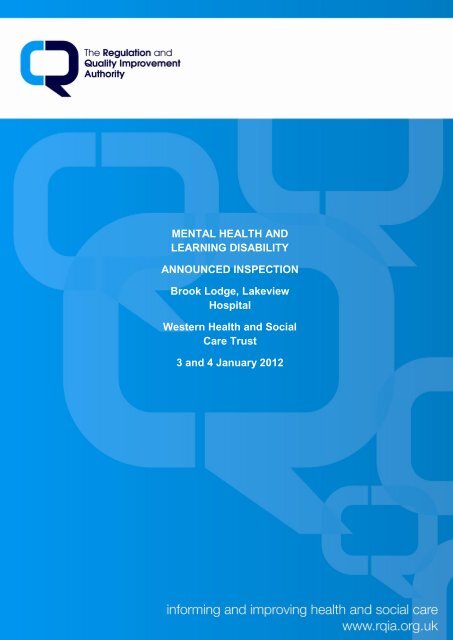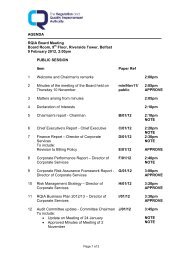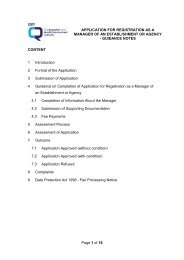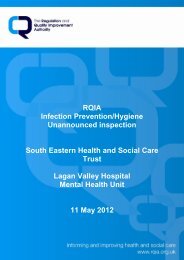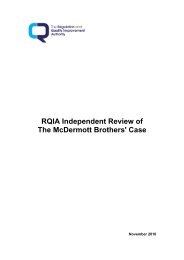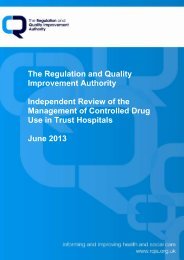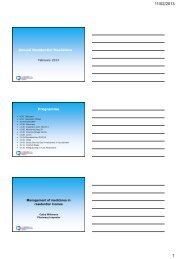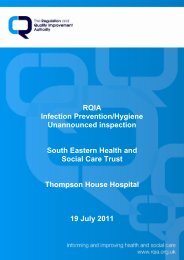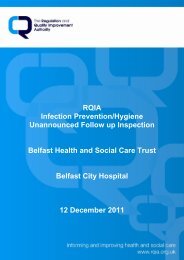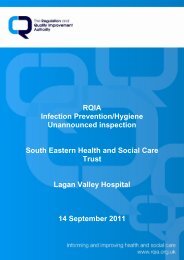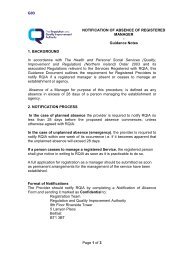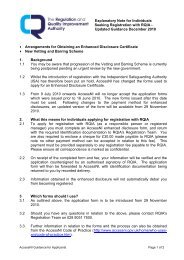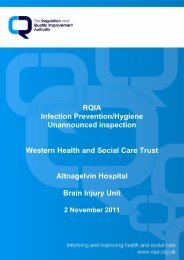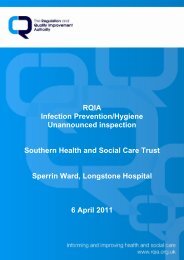Brook Lodge, Lakeview Hospital - Regulation and Quality ...
Brook Lodge, Lakeview Hospital - Regulation and Quality ...
Brook Lodge, Lakeview Hospital - Regulation and Quality ...
You also want an ePaper? Increase the reach of your titles
YUMPU automatically turns print PDFs into web optimized ePapers that Google loves.
MENTAL HEALTH AND<br />
LEARNING DISABILITY<br />
ANNOUNCED INSPECTION<br />
<strong>Brook</strong> <strong>Lodge</strong>, <strong>Lakeview</strong><br />
<strong>Hospital</strong><br />
Western Health <strong>and</strong> Social<br />
Care Trust<br />
3 <strong>and</strong> 4 January 2012<br />
1
Table of Contents<br />
1.0 Introduction ............................................................................................ 3<br />
2.0 Ward Profile ........................................................................................... 4<br />
3.0 Inspection Summary .............................................................................. 6<br />
4.0 Stakeholder Engagement ....................................................................... 8<br />
5.0 Additional concerns noted by Inspectors (if applicable) ....................... 10<br />
6.0 RQIA Compliance Scale Guidance ...................................................... 11<br />
7.0 Summary of Compliance – RQIA Assessment ..................................... 12<br />
Appendix 1 – <strong>Quality</strong> Improvement Plan ........................................................ 15
1.0 Introduction<br />
The <strong>Regulation</strong> <strong>and</strong> <strong>Quality</strong> Improvement Authority (RQIA) is the independent<br />
body responsible for regulating <strong>and</strong> inspecting the quality <strong>and</strong> availability of<br />
Northern Irel<strong>and</strong>‟s health <strong>and</strong> social care services. RQIA was established<br />
under the Health <strong>and</strong> Personal Social Services (<strong>Quality</strong>, Improvement <strong>and</strong><br />
<strong>Regulation</strong>) (Northern Irel<strong>and</strong>) Order 2003, to drive improvements for<br />
everyone using health <strong>and</strong> social care services.<br />
On 24 October 2011 RQIA informed the Trust of the inspection date <strong>and</strong><br />
forwarded the associated inspection documentation. RQIA adopted the<br />
approach of self-assessment, which allowed the ward the opportunity to<br />
demonstrate its ability to deliver a service against best practice indicators.<br />
This included the assessment of the Trust‟s performance against an RQIA<br />
Compliance Scale, as outlined in Section 6.<br />
The inspection process included an analysis of the ward‟s self-assessment,<br />
other associated information, discussions with ward staff, patients <strong>and</strong><br />
relatives. A range of multi-disciplinary records, policies <strong>and</strong> procedures were<br />
also examined as part of the inspection.<br />
The recommendations made during the previous inspection on 30 September<br />
<strong>and</strong> 1 October 2010 were also assessed during this inspection to determine<br />
the Trust‟s progress towards compliance. The inspector found compliance in<br />
the following areas:<br />
Admission documentation<br />
Documentation in relation to patients‟ contact with their consultant<br />
Provision of records management training<br />
Replacement flooring<br />
Bathroom repairs completed<br />
Appropriate storage of linen <strong>and</strong> consumables.<br />
However, in spite of assurances from the Trust, several recommendations<br />
remained outst<strong>and</strong>ing from the previous inspection. Any previously stated<br />
recommendations that were outst<strong>and</strong>ing were added to the <strong>Quality</strong><br />
Improvement Plan for action (reference Appendix 1).<br />
An overall summary of the ward‟s performance against the human rights<br />
theme of Protection is in Section 3 <strong>and</strong> full details of the inspection findings<br />
are outlined in Appendix 2.<br />
3
2.0 Ward Profile<br />
Trust<br />
Name of hospital/facility<br />
Address<br />
Western Health <strong>and</strong> Social Care Trust<br />
<strong>Lakeview</strong> <strong>Hospital</strong>, <strong>Brook</strong> <strong>Lodge</strong><br />
Gransha Park<br />
Clooney Road<br />
Londonderry<br />
BT47 6TF<br />
Telephone number 028 71 382950<br />
Person in charge on day of inspection<br />
Lorraine Feeney<br />
Email address<br />
Nature of service - MH/LD<br />
Learning disability<br />
Name of ward/s <strong>and</strong> category of care<br />
<strong>Brook</strong> <strong>Lodge</strong>, acute admissions<br />
Number of patients <strong>and</strong> occupancy<br />
level on days of inspection<br />
10 bed ward, 9 beds occupied during<br />
inspection period<br />
Number of detained patients on days<br />
of inspection<br />
3<br />
Date of last inspection 30 September <strong>and</strong> 1 October 2010<br />
Ward Profile:<br />
<strong>Brook</strong> <strong>Lodge</strong> is an inpatient facility for adults with a learning disability in<br />
<strong>Lakeview</strong> <strong>Hospital</strong>. There are ten beds in the ward <strong>and</strong> it serves as the<br />
hospital's admission facility <strong>and</strong> provides assessment <strong>and</strong> treatment services.<br />
The ward provides single room accommodation to male <strong>and</strong> female patients<br />
<strong>and</strong> there are two spacious sitting rooms, a quiet room, dining room <strong>and</strong> a<br />
number of toilets accessible to patients. Two of the bedrooms have en suite<br />
4
facilities <strong>and</strong> there is a bathroom <strong>and</strong> shower room available to patients. Two<br />
of the bedrooms are located next to the nurse's station <strong>and</strong> are described as<br />
assessment rooms.<br />
The ward also contains a kitchen, a clinical room, sluice room, office <strong>and</strong> a<br />
number of storage areas for linen etc.<br />
At the time of the inspection there were nine patients being cared for on the<br />
ward. There were three detained patients <strong>and</strong> several patients had been in<br />
the hospital for a number of years <strong>and</strong> were awaiting community resettlement.<br />
Inspectors were advised that regular meetings take place between hospital<br />
senior management staff, medical staff <strong>and</strong> community teams to discuss the<br />
resettlement needs of specific patients.<br />
Patients have access to a consultant psychiatrist, psychologist <strong>and</strong> most<br />
patients attend the Berryburn Centre which provides day time activities <strong>and</strong> is<br />
within the <strong>Lakeview</strong> site.<br />
5
3.0 Inspection Summary<br />
An announced inspection of <strong>Brook</strong> <strong>Lodge</strong> was undertaken on 3 <strong>and</strong> 4 January<br />
2012. The purpose of this inspection was to assess the ward‟s arrangements<br />
<strong>and</strong> procedures for safeguarding vulnerable adults.<br />
The ward‟s progress towards compliance with recommendations made during<br />
the previous inspection was assessed <strong>and</strong> a number of recommendations<br />
were restated as insufficient progress had been made. These areas for<br />
quality improvement included:<br />
the provision of advocacy services<br />
staff training in restrictive interventions including physical restraint<br />
staff training in the protection of vulnerable adults<br />
staff training in h<strong>and</strong>ling complaints<br />
development of the whistle blowing policy to include contact details of<br />
external organisations <strong>and</strong> agencies.<br />
patients‟ involvement in care planning, discharge planning <strong>and</strong> in the<br />
multi-disciplinary meetings<br />
the provision of complaints information in an appropriate format.<br />
The following is a summary of the inspection findings of the arrangements for<br />
safeguarding vulnerable adults on this ward.<br />
Inspectors noted a significant number of incidents had occurred on the ward<br />
involving patients assaulting each other <strong>and</strong> in some cases, sustaining injuries<br />
such as breaks to skin <strong>and</strong> bruising. There was evidence of patients<br />
experiencing repeated assaults from other individual patients <strong>and</strong> of a<br />
patient‟s relatives raising concerns about patient safety on the ward.<br />
Inspectors raised concerns that the Trust‟s protection of vulnerable adults<br />
procedures were not being followed, adult protection concerns were not being<br />
adequately reported or investigated <strong>and</strong> there was poor evidence of<br />
documented protection arrangements.<br />
In spite of assurances provided to RQIA from the Trust, following the previous<br />
inspection (October 2010), a significant number of staff still had not received<br />
training in the protection of vulnerable adults.<br />
The staff induction records did not provide evidence that new staff had been<br />
given guidance on the ward‟s procedures for safeguarding vulnerable adults.<br />
Inspectors were of the opinion that insufficient action was taken to promote<br />
the safety <strong>and</strong> wellbeing of patients on the ward <strong>and</strong> noted that patients had<br />
suffered harm during their inpatient stay. Details of specific concerns were<br />
shared with senior Trust staff following the inspection.<br />
6
The needs assessments, care plans <strong>and</strong> other multi-disciplinary<br />
documentation of a number of patients were examined. The Inspector noted<br />
that several patients did not have up to date care plans <strong>and</strong> some of the care<br />
plans were not dated.<br />
Some care plans had been developed during previous admissions but did not<br />
reflect current assessed needs.<br />
The staff training records were examined <strong>and</strong> contained some evidence of<br />
staff having received update training in the protection of vulnerable adults.<br />
It was recommended in the previous inspection report that all staff would<br />
receive this training. Inspectors were concerned to note that insufficient<br />
progress towards compliance had been made in this area.<br />
Inspectors were also very concerned to note that staff working in <strong>Brook</strong> <strong>Lodge</strong><br />
were caring for a patient who presented with significant challenging<br />
behaviours, including violence <strong>and</strong> aggression. Staff were noted to have used<br />
physical interventions in the management of the patient however only 4 have<br />
staff received accredited training in the use of physical interventions.<br />
Inspectors provided feedback in relation to the findings at the end of the<br />
second day of the inspection. RQIA also wrote to the Trust on 9 January<br />
2012 to seek assurances in relation to the issues identified during the<br />
inspection.<br />
The Trust have provided an action plan in relation to the specific issues raised<br />
by RQIA <strong>and</strong> progress towards the satisfactory <strong>and</strong> timely compliance in these<br />
areas will be closely monitored.<br />
Inspectors would like to thank the patients, staff, relatives <strong>and</strong> visiting<br />
professionals for their cooperation throughout the inspection process.<br />
7
4.0 Stakeholder Engagement<br />
Questionnaires were issued to staff, patients, relatives/ carers <strong>and</strong> visiting<br />
professionals in advance of the inspection. The responses from the<br />
questionnaires were used to inform the inspection process.<br />
Number Number<br />
Questionnaires issued to<br />
issued returned<br />
Patients 10 3<br />
Carers/Relatives 10 3<br />
Visiting Professional 10 6<br />
Staff 10 3<br />
During the inspection the inspector has the opportunity to meet with staff,<br />
patients, relatives/ carers, visiting professionals or advocates. Below are the<br />
details of the number of discussions held during the inspection.<br />
Additional discussions during inspection<br />
Number<br />
Patients 3<br />
Carers/Relatives 0<br />
Visiting Professionals 0<br />
Staff 4<br />
Advocates 0<br />
The following information is a summary of feedback received from those who<br />
returned a questionnaire or met with an inspector during the inspection.<br />
Patients:<br />
The patients who participated in the inspection indicated that they didn‟t<br />
always feel safe on the ward <strong>and</strong> two patients advised the inspector they were<br />
unaware of the ward‟s complaints procedures.<br />
Two patients referred to incidents in which they had been assaulted by other<br />
patients <strong>and</strong> one patient advised the inspector that their personal property had<br />
been damaged by another patient.<br />
Suggestions for quality improvement made by patients included the provision<br />
of a games room on the ward <strong>and</strong> more meetings about resettlement.<br />
Carers/ Relatives:<br />
Three relatives returned a questionnaire <strong>and</strong> the suggestions for quality<br />
improvement made included the provision of more fresh fruit, games <strong>and</strong><br />
books to patients on the ward. One relative suggested that ward staff should<br />
not use their mobile phones when working on the ward.<br />
One relative suggested that they would like to be more informed about the<br />
wellbeing of their relative.<br />
8
Another relative referred to incidents on the ward in which their relative had<br />
been assaulted by another patient <strong>and</strong> had sustained injuries. This relative<br />
also referred to their relative‟s property going missing.<br />
These issues <strong>and</strong> suggestions for quality improvement were discussed with<br />
staff during the inpseciton <strong>and</strong> with hospital management during the feedback<br />
session at the end of the inspection visit.<br />
Visiting professionals:<br />
The professionals who returned a questionnaire indicated they have regular<br />
contact with the ward <strong>and</strong> one professional commented:<br />
“I am happy with the care afforded to clients in <strong>Brook</strong> <strong>Lodge</strong> – there is good<br />
disciplinary approaches to assessment, setting up care plans <strong>and</strong><br />
management”.<br />
Suggestions for quality improvement made by visiting professionals included<br />
the provision of „breakaway‟ training for visiting staff <strong>and</strong> the provision of more<br />
staff <strong>and</strong> more staff induction for new staff.<br />
Staff:<br />
Staff who participated in the inspection made a number of suggestions for<br />
quality improvement. These included the provision of training for unqualified<br />
staff, more staff meetings <strong>and</strong> more support for staff when dealing with<br />
patients who present with aggressive <strong>and</strong> violent behaviours.<br />
9
5.0 Additional concerns noted by Inspectors<br />
A female patient‟s bedroom curtains were noted to be missing on the first day<br />
of the inspection <strong>and</strong> the inspector was advised these would be re-hung<br />
before the end of the day.<br />
The patient was described as having an intolerance of curtains <strong>and</strong> had a<br />
history of pulling them down in her bedroom <strong>and</strong> in the living room. The<br />
inspector visited the patients bedroom on the second day of the inspection<br />
<strong>and</strong> noted that the curtains had not been rehung. Staff confirmed that the<br />
curtains had not been in place since the patient pulled them down „several<br />
days ago‟. The ward manager reported that the curtains were ripped <strong>and</strong><br />
would require sewing before they could be re-hung. The inspector was also<br />
advised that the patient would not be afforded the option of washing or<br />
changing in her bedroom when there were no curtains in place <strong>and</strong> that this<br />
caused the patient a degree of agitation.<br />
The Inspector raised concerns that the patient‟s privacy was being<br />
unreasonably compromised <strong>and</strong> that her bedroom was overlooked by<br />
administration buildings <strong>and</strong> a public pathway.<br />
Inspectors requested that an alternative window covering be sought urgently<br />
for this patient to promote her privacy.<br />
10
6.0 RQIA Compliance Scale Guidance<br />
Guidance - Compliance statements<br />
Compliance statement<br />
0 - Not applicable<br />
1 - Unlikely to become<br />
compliant<br />
2 - Not compliant<br />
3 - Moving towards<br />
compliance<br />
Definition<br />
Compliance with this criterion does<br />
not apply to this ward.<br />
Compliance will not be demonstrated<br />
by the date of the inspection.<br />
Compliance could not be<br />
demonstrated by the date of the<br />
inspection.<br />
Compliance could not be<br />
demonstrated by the date of the<br />
inspection. However, the service<br />
could demonstrate a convincing plan<br />
for full compliance by the end of the<br />
inspection year.<br />
Resulting Action in<br />
Inspection Report<br />
A reason must be clearly stated in<br />
the assessment contained within the<br />
inspection report<br />
A reason must be clearly stated in<br />
the assessment contained within the<br />
inspection report<br />
In most situations this will result in a<br />
requirement or recommendation<br />
being made within the inspection<br />
report<br />
In most situations this will result in a<br />
recommendation being made within<br />
the inspection report<br />
4 - Substantially<br />
Compliant<br />
Arrangements for compliance were<br />
demonstrated during the inspection.<br />
However, appropriate systems for<br />
regular monitoring, review <strong>and</strong><br />
revision are not yet in place.<br />
In most situations this will result in a<br />
recommendation, or in some<br />
circumstances a recommendation,<br />
being made within the Inspection<br />
Report<br />
5 - Compliant<br />
Arrangements for compliance were<br />
demonstrated during the inspection.<br />
There are appropriate systems in<br />
place for regular monitoring, review<br />
<strong>and</strong> any necessary revisions to be<br />
undertaken.<br />
In most situations this will result in<br />
an area of good practice being<br />
identified <strong>and</strong> being made within the<br />
inspection report.<br />
11
Compliant<br />
Substantially<br />
Compliant<br />
Moving<br />
Towards<br />
Compliance<br />
Not Compliant<br />
Unlikely to<br />
become<br />
compliant<br />
Not Applicable<br />
7.0 Summary of Compliance – RQIA Assessment<br />
No.<br />
Question<br />
1<br />
2<br />
3<br />
4<br />
5<br />
6<br />
7<br />
8<br />
9<br />
10<br />
How do you ensure that everyone<br />
involved with the ward is aware of<br />
<strong>and</strong> underst<strong>and</strong>s the safeguarding<br />
vulnerable adult policy?<br />
List the additional procedures <strong>and</strong><br />
guidelines that you use to support<br />
the safeguarding vulnerable adult<br />
policy.<br />
List the additional procedures <strong>and</strong><br />
guidelines, aimed at promoting<br />
safe <strong>and</strong> healthy working<br />
practices, which you use to<br />
support the safeguarding<br />
vulnerable adult policy.<br />
Outline how the ward is involved in<br />
the review of the Trust‟s<br />
safeguarding vulnerable adult<br />
policy, the code of behaviour <strong>and</strong><br />
the other associated procedures<br />
<strong>and</strong> guidelines.<br />
Outline how new staff are<br />
appropriately inducted into the<br />
ward.<br />
Describe how staff training needs,<br />
appropriate to the post/ role, are<br />
identified.<br />
Outline the arrangements in place for:<br />
(i) the support <strong>and</strong> supervision of all<br />
staff<br />
(ii) the annual appraisal of staff <strong>and</strong><br />
the review of volunteers<br />
Describe the arrangements in place<br />
for maintaining written records of:<br />
training completed; support <strong>and</strong><br />
supervision; <strong>and</strong> annual appraisals<br />
<strong>and</strong> reviews.<br />
Describe how the ward ensures staff<br />
<strong>and</strong> volunteers comply with the<br />
Safeguarding Vulnerable Adults<br />
St<strong>and</strong>ard 4.<br />
Outline the steps the ward has taken<br />
to ensure that staff <strong>and</strong> volunteers are<br />
competent to recognise signs of<br />
abuse.<br />
<br />
<br />
<br />
<br />
<br />
<br />
<br />
<br />
<br />
<br />
12
Compliant<br />
Substantially<br />
Compliant<br />
Moving<br />
Towards<br />
Compliance<br />
Not Compliant<br />
Unlikely to<br />
become<br />
compliant<br />
Not Applicable<br />
No.<br />
Question<br />
11<br />
Describe how the ward identifies <strong>and</strong><br />
manages risks for individual patients.<br />
<br />
12<br />
Outline the mechanisms used by the<br />
ward to ensure that vulnerable adults<br />
have the right to take risks in relation<br />
to their care.<br />
<br />
13<br />
14<br />
15<br />
16<br />
17<br />
18<br />
19<br />
20<br />
Describe how the reporting, recording<br />
<strong>and</strong> reviewing accidents, incidents<br />
<strong>and</strong> near misses informs <strong>and</strong><br />
influences ward practice <strong>and</strong> the risk<br />
assessment <strong>and</strong> management<br />
procedures.<br />
Describe how the ward promotes <strong>and</strong><br />
communicates the Trust‟s „ethos of<br />
inclusion, transparency <strong>and</strong><br />
openness‟ to vulnerable adults,<br />
carers, advocates, family members,<br />
staff <strong>and</strong> volunteers.<br />
Describe the procedures in place for<br />
carers, advocates <strong>and</strong> vulnerable<br />
adults to share concerns they may<br />
have or to make complaints about the<br />
organisation.<br />
Outline the steps the ward has taken<br />
to encourage carers, advocates <strong>and</strong><br />
vulnerable adults to raise concerns or<br />
make a complaint following an<br />
incident.<br />
Outline how the ward ensures that<br />
staff know <strong>and</strong> comply with the<br />
records management policy.<br />
Outline the mechanisms the trust has<br />
in place to inform vulnerable adults<br />
about their right to access to<br />
information held about them.<br />
Describe how the ward ensures that<br />
staff, volunteers <strong>and</strong> visitors know<br />
about <strong>and</strong> adhere to the Code of<br />
Behaviour.<br />
outline how the ward safeguards<br />
patients‟ rights in relation to the use<br />
of:<br />
(i) restrictions on the ward<br />
(ii) isolation/ seclusion<br />
(iii) close observation<br />
(iv) restraint<br />
<br />
<br />
<br />
<br />
<br />
<br />
<br />
<br />
13
Compliant<br />
Substantially<br />
Compliant<br />
Moving<br />
Towards<br />
Compliance<br />
Not Compliant<br />
Unlikely to<br />
become<br />
compliant<br />
Not Applicable<br />
No.<br />
Question<br />
21<br />
Outline the mechanisms for the<br />
h<strong>and</strong>ling of vulnerable adults‟ money.<br />
<br />
22<br />
23<br />
24<br />
Outline how the ward ensures the<br />
safety of patients‟ property while on<br />
the ward.<br />
Describe what arrangements the ward<br />
has in place for children visiting the<br />
ward.<br />
Outline the safeguarding<br />
arrangements the ward has in place<br />
for the admission of an under 18 year<br />
old.<br />
<br />
<br />
<br />
14
Appendix 1 – <strong>Quality</strong> Improvement Plan<br />
QUALITY IMPROVEMENT PLAN<br />
ANNOUNCED INSPECTION<br />
<strong>Brook</strong> <strong>Lodge</strong>, <strong>Lakeview</strong> <strong>Hospital</strong><br />
3 <strong>and</strong> 4 January 2012<br />
The issue(s) identified during this inspection are detailed in the <strong>Quality</strong> Improvement Plan.<br />
The details of the <strong>Quality</strong> Improvement Plan were discussed at a feedback meeting which was attended by the Ward Manager,<br />
Director of Mental Health <strong>and</strong> Learning Disability, Assistant Director of Learning Disability services, Head of Service, Head of<br />
<strong>Hospital</strong> Services, Consultant Psychiatrist.<br />
15
1. RECOMMENDATIONS RESTATED FROM PREVIOUS INSPECTION<br />
RECOMMENDATIONS RESTATED FROM PREVIOUS<br />
INSPECTIONS<br />
It is recommended that the Trust review the arrangements to enable all<br />
patients to access independent advocacy services.<br />
It is recommended that information about patients‟ rights is produced in<br />
a format suitable to the needs of individual patients.<br />
NUMBER OF<br />
TIMES<br />
STATED<br />
DETAILS OF ACTION TO<br />
BE TAKEN<br />
2 In <strong>Brook</strong> <strong>Lodge</strong> - all patients<br />
who receive assessment <strong>and</strong><br />
treatment have good family<br />
involvement - who, along with<br />
staff will advocate on the<br />
patients' behalf. The<br />
programme has a small amount<br />
of funding available <strong>and</strong> is<br />
currently developing a service<br />
specification to go to tender to<br />
procure an advocacy service.<br />
The procurement process will<br />
progress in the third quarter of<br />
this year 2012. However if a<br />
need presents, the Trust will<br />
source indpendent advocacy.<br />
2 This is facilitated by<br />
implementing augmentative<br />
<strong>and</strong> alternative communication<br />
systems such as interpreters<br />
coming into the ward <strong>and</strong><br />
TIMESCALE<br />
31 July 2012<br />
Immediate <strong>and</strong> on-going<br />
16
It is recommended that all staff receive training in dealing with<br />
complaints.<br />
colour picture cards, "A Guide<br />
to the Human Rights Act" a<br />
booklet for people with learning<br />
disabilities, produced by<br />
Ministry of Justice. WHSCT -<br />
Equality Scheme - easy read<br />
booklet & easy read "Ours to<br />
Own Your Human Rights" by<br />
Equality & Human Rights<br />
Commission. Whereby a patient<br />
lacks capacity, these rights are<br />
explained to their relatives or<br />
carers. A list of patient rights is<br />
included in the Strule <strong>Lodge</strong><br />
information leaflet given to<br />
patient <strong>and</strong>/or family on an<br />
admission.<br />
2 An education consultancy is<br />
being facilitated by the<br />
complaints department <strong>and</strong><br />
training will be provided on site<br />
for all staff by end of October<br />
2012 <strong>and</strong> discussed at<br />
induction. A list of training<br />
needs were identified <strong>and</strong><br />
balanced with care needs on<br />
31 May 2012<br />
17
It is recommended that information about the complaints procedures is<br />
produced in a format suitable to the individual needs of the patinets.<br />
It is recommended that protocols for restrictive practices including<br />
physical interventions are clearly documented in care records <strong>and</strong> that<br />
any such interventions are recorded accurately <strong>and</strong> in detail.<br />
the ward. M<strong>and</strong>atory training<br />
was prioritised for example<br />
MATHS 5 day training,<br />
Vulnerable Adult training,<br />
Record <strong>and</strong> Record Keeping <strong>and</strong><br />
others. Taking into account<br />
staffing levels <strong>and</strong> summer<br />
'peak' leave time, complaints<br />
training will be provided on site<br />
for all staff on 27th September,<br />
2nd October <strong>and</strong> 26th October<br />
2012. Complaints leaflets are<br />
available on the ward <strong>and</strong><br />
complaints flow chart on wall.<br />
2 WHSCT - <strong>Lakeview</strong> brochure<br />
on ward in pictorial format, plus<br />
posters on the wall <strong>and</strong><br />
information leaflets available.<br />
This is incorporated during<br />
admission process <strong>and</strong> included<br />
in admission checklist under<br />
patient's rights.<br />
2 All patients who require<br />
restrictive practices including<br />
physical interventions will have<br />
Immediate <strong>and</strong> on-going<br />
Immediate <strong>and</strong> on-going<br />
18
It is recommended that patients are reminded regularly of the ward‟s<br />
policy on encouraging patients to attend the weekly multi-disciplinary<br />
meeting <strong>and</strong> that patients‟ views are documented.<br />
risk assessment for restrictive<br />
interventions with a care plan.<br />
All interventions recorded in<br />
daily recordings after discussion<br />
<strong>and</strong> decision. Staff have<br />
received training in MATHS <strong>and</strong><br />
restrictive interventions training<br />
will be rolled out commencing<br />
24/09/12 throughout the Trust.<br />
Staff in <strong>Brook</strong> have read the<br />
Restrictive Interventions Policy<br />
<strong>and</strong> signed that they have read<br />
this.<br />
2 All patients who have capacity<br />
to underst<strong>and</strong> are offered an<br />
opportunity to attend weekly<br />
MDT ward round. Patient views<br />
are recorded during weekly<br />
ward rounds or daily SHO<br />
round. Patient views are<br />
recorded by Consultant in<br />
medical notes, nursing staff in<br />
daily recording of nursing<br />
process <strong>and</strong> by any other<br />
members of the Multi-<br />
Disciplinary Team attending the<br />
Immediate <strong>and</strong> on-going<br />
19
It is recommended that patients are involved in all aspects of the<br />
discharge plan <strong>and</strong> that their views are sought <strong>and</strong> documented.<br />
It is recommended that the arrangements for observing patients using<br />
the assessment bedrooms are reviewed <strong>and</strong> that this is undertaken on<br />
the basis of identified need. It is also recommended that when patients<br />
do not requie this level of observation, they are afforded maximum<br />
privacy.<br />
It is recommended that all staff receive training in challenging<br />
behaviour, to include the use of restrictive practices <strong>and</strong> physical<br />
interventions.<br />
weekly Multi-Disciplinary ward<br />
round.<br />
2 Discharge planning<br />
commenced on admission - predischarge<br />
meetings <strong>and</strong><br />
discussions with patient, MDT<br />
<strong>and</strong> family are documented in<br />
care plans/medical notes<br />
2 Assessment bedrooms are only<br />
used for 1:1 prescribed<br />
observations. A velcro blind is<br />
on the observation windows at<br />
all other times.<br />
2 All seventeen staff in <strong>Brook</strong><br />
<strong>Lodge</strong> have been offered<br />
M.A.T.H.S training - 15 staff are<br />
now trained <strong>and</strong> 2 staff have<br />
been referred to occupational<br />
health after being deemed<br />
medically unfit to complete the<br />
training. These two staff will be<br />
trained when occupational<br />
health declare them medically<br />
fit. Staff have received training<br />
Immediate <strong>and</strong> on-going<br />
Immediate <strong>and</strong> on-going<br />
31 May 2012<br />
20
in MATHS <strong>and</strong> restrictive<br />
interventions training will be<br />
rolled out commencing<br />
24/09/12 throughout the Trust.<br />
Staff in <strong>Brook</strong> have read the<br />
Restrictive Interventions Policy<br />
<strong>and</strong> signed that they have read<br />
this.<br />
It is recommended that all staff receive update training in the protection<br />
of vulnerable adults.<br />
2 Immediate <strong>and</strong> on-going<br />
21
2. RECOMMENDATIONS MADE FOLLOWING INSPECTION OF SAFEGUARDING VULNERABLE ADULTS AND CHILDREN – HUMAN<br />
RIGHTS THEME OF PROTECTION<br />
RECOMMENDATIONS<br />
DETAILS OF ACTION TO<br />
BE TAKEN<br />
TIMESCALE<br />
1. Staff induction, training, supervision <strong>and</strong> appraisal.<br />
It is recommended that the Whistleblowing policy is developed to include the contact<br />
details of external organisations <strong>and</strong> agencies.<br />
It is recommended that staff induction records are completed <strong>and</strong> that staff receive<br />
guidance in relation to the ward‟s SafeguardingVulnerable Adults procedures.<br />
The <strong>Hospital</strong> Manager spoke to<br />
Risk Management Department<br />
to advise them of this<br />
recommendation. Advised<br />
current policy (dated June 2011)<br />
Based on regional guidance <strong>and</strong><br />
DHSS circulars - a request for<br />
further clarification on RQIA's<br />
recommendation - ref per 14 a<br />
referral is made to external<br />
bodies.<br />
16/17 staff in <strong>Brook</strong> are<br />
trained in Vulnerable Adults -<br />
<strong>and</strong> Vulnerable Adult<br />
procedures are included on staff<br />
induction forms. Staff receive<br />
ongoing guidance on vulnerable<br />
adult procedures at ward<br />
30 April 2012<br />
Immediate <strong>and</strong> on-going<br />
22
It is recommended that the acting ward manager <strong>and</strong> all staff on the ward receive<br />
regular supervision <strong>and</strong> appraisal.<br />
It is recommended that regular staff meetings are held <strong>and</strong> that all staff have the<br />
opportunity to attend these.<br />
It is recommended that a staff training <strong>and</strong> development plan is developed for the ward<br />
<strong>and</strong> that all training needs are identified <strong>and</strong> actioned.<br />
meetings, supervision sessions<br />
<strong>and</strong> posters are displayed on<br />
safeguarding vulnerable adults.<br />
The Ward Manager attended<br />
training on 30/6/12 <strong>and</strong> has<br />
completed six appraisals to date<br />
- all to be completed by mid<br />
November 2012 <strong>and</strong> staff have<br />
been allocated dates for their<br />
annual appraisal.<br />
Staff meetings are held 4-6<br />
weekly - or more often if<br />
required. Notices are put up<br />
detailing date <strong>and</strong> time of<br />
meeting <strong>and</strong> staff are verbally<br />
invited to attend as well.<br />
This is incorporated in the<br />
annual appraisals. A training file<br />
kept on the ward. All m<strong>and</strong>atory<br />
training needs are identified<br />
<strong>and</strong> records kept of attendance<br />
<strong>and</strong> refresher dates. A weekly<br />
record of attendance of training<br />
is kept. A training needs analysis<br />
31 July 2012<br />
Immediate <strong>and</strong> on-going<br />
Immediate <strong>and</strong> on-going<br />
23
for m<strong>and</strong>atory training <strong>and</strong><br />
commissioned courses are<br />
formulised through the WHSCT<br />
Education, Learning <strong>and</strong><br />
Development sub-group.<br />
2. Awareness <strong>and</strong> implementation of procedures for the protection of vulnerable adults.<br />
It is recommended that all staff receive training <strong>and</strong> information in relation to the<br />
application of the Trust‟s safeguarding vulnerable adults procedures to their area of<br />
work.<br />
16/17 staff in<strong>Brook</strong> <strong>Lodge</strong><br />
have been trained in Vulnerable<br />
Adult Procedures - other staff<br />
member just returned from sick<br />
leave is booked on to next<br />
training session on 7/12/12<br />
Immediate <strong>and</strong> on-going<br />
3. Incident reporting <strong>and</strong> risk management.<br />
It is recommended that all incidents in which patients suffer or at risk of harm are<br />
considered withn the context of the Trust‟s safeguarding adults procedures.<br />
All incidents in which patients<br />
are at risk of harm - or suffer<br />
harm are recorded, a VA1<br />
referral form is completed <strong>and</strong><br />
forwarded to the Designated<br />
Officer in conjunction with<br />
DATIX forms, daily recording<br />
notes completed <strong>and</strong> all Trust<br />
Polices followed. As is current<br />
practice, staff continue to<br />
report all untoward incidents<br />
Immediate <strong>and</strong> on-going<br />
24
via the Trust's Incident<br />
Reporting Procedures (DATIX).<br />
Staff continue to record all<br />
assaults <strong>and</strong> immediate action<br />
take in individuals' nursing<br />
processes. This recording will<br />
detail antecedent, actual<br />
behaviour (assault),<br />
consequences <strong>and</strong> possible<br />
contributory factors.<br />
Appropriate care planning<br />
either initiated or reviewed<br />
within both 'victim' <strong>and</strong><br />
perpetrator's notes so as to<br />
minimise risk of re-occurrence.<br />
As is current practice, staff<br />
continue to inform next of<br />
kin/care(s) of all assaults <strong>and</strong><br />
untoward incidents. Nursing<br />
staff discuss with multidisciplinary<br />
team immediately<br />
or at earliest opportunity as<br />
deemed necessary having<br />
assessed the situation.<br />
Consultation between learning<br />
disability services <strong>and</strong> the<br />
25
It is recommended that patients‟ relatives are informed of incidents or significant events<br />
occurring on the ward.<br />
Trust's Adult Safeguarding Team<br />
Lead initiated with regard to<br />
VA1 referral processes,<br />
thresholds of behaviours, trends<br />
of individuals' behaviours <strong>and</strong><br />
protection plans in keeping with<br />
regional guidance.<br />
All relatives, with the patient's<br />
consent are informed of all<br />
incidents or significant events.<br />
All untoward incidents are<br />
reported via the Trust's Incident<br />
Reporting Procedure (DATIX).<br />
VA1referral forms are<br />
completed. Staff record<br />
conversation with relatives in<br />
patient's nursing process. On<br />
admission, a contract<br />
agreement form is completed to<br />
get contact details <strong>and</strong><br />
frequency of information<br />
sharing preferred <strong>and</strong> is in the<br />
patient's nursing process for all<br />
staff's information.<br />
Immediate <strong>and</strong> on-going<br />
4. Comments, concerns <strong>and</strong> complaints.<br />
26
It is recommended that the arrangements for the frequency <strong>and</strong> appropriateness of<br />
sharing pertinent information with relatives are reviewed <strong>and</strong> agreed with relatives <strong>and</strong><br />
that these are documented within the patients‟ records.<br />
It is recommended that patients are provided with further opportunities to raise<br />
concerns in relation to their care <strong>and</strong> that these include the provision of advocacy<br />
services <strong>and</strong> patients‟ meetings.<br />
On all occassions , consent to<br />
share information will be<br />
obtained from patient - if able<br />
to give consent <strong>and</strong> recorded in<br />
nursing process - a contact<br />
details sheet has been<br />
formulated to gather this<br />
information. Any information<br />
given to relatives recorded in<br />
nursing process in daily<br />
recordings.<br />
Patients can raise concerns<br />
to nursing staff, key workers or<br />
family members. The<br />
programme has a small amount<br />
of funding available <strong>and</strong> is<br />
currently developing a service<br />
specification to go to tender to<br />
procure an advocacy service.<br />
The procurement process will<br />
progress in the third quarter of<br />
this year 2012. However if a<br />
need presents, the Trust will<br />
source independent advocacy.<br />
Immediate <strong>and</strong> on-going<br />
31 May 2012<br />
5. Patients’ rights.<br />
27
It is recommended that user friendly information is developed to inform patients of their<br />
right to access information held about them.<br />
Patients who have capacity to<br />
underst<strong>and</strong> are verbally told<br />
about this right <strong>and</strong> an<br />
information leaflet given to<br />
them - 'Access to health<br />
Records' which contains the<br />
application forms to access the<br />
records. The information leaflet<br />
'Access to Health' records is<br />
available on the ward. On<br />
admission, patients who have<br />
the capacity to underst<strong>and</strong> are<br />
verbally told about this leaflet<br />
<strong>and</strong> staff will assist the patient<br />
in explaining the information<br />
<strong>and</strong> processes for accessing<br />
information held about them. If<br />
the patient lacks capacity, the<br />
relatives will be given<br />
information about accessing<br />
information. The leaflet<br />
contains an application form to<br />
access their records <strong>and</strong> staff or<br />
family will assist the patient to<br />
complete this if they wish to<br />
access their notes.<br />
31 July 2012<br />
28
6. Patients’ money <strong>and</strong> property.<br />
It is recommended that patients who cannot safeguard their property on the ward are<br />
provided with adequate support.<br />
All patients have their own<br />
individual cash records. All<br />
property on admission recorded<br />
<strong>and</strong> checked on discharge.<br />
Advice from nursing staff on<br />
property safety <strong>and</strong> assistance<br />
to that patients safeguard their<br />
property at all times on ward.<br />
Immediate <strong>and</strong> on-going<br />
6. Child Protection.<br />
It is recommended that staff undertake training in child protection.<br />
A consultancy request has<br />
been made to education<br />
provider, NEDC to provide Level<br />
One Child Protection training on<br />
site over 2 - 4 dates to ensure<br />
all staff obtain safeguarding<br />
Children Level One training for<br />
nursing staff <strong>and</strong> untrained staff<br />
will receive awareness session<br />
in child protection.<br />
31 July 2012<br />
7. Additional Recommendations.<br />
It is recommended that the arrangements for providing adequate window coverings <strong>and</strong><br />
privacy in patients‟ bedrooms are reviewed <strong>and</strong> that alternatives to curtains are<br />
explored <strong>and</strong> provided.<br />
Alternatives to curtains have<br />
been researched, including<br />
discussions with other facilities<br />
Immediate <strong>and</strong> on-going<br />
29
<strong>and</strong> hospitals. Adhesive privacy<br />
screens have been applied to<br />
the windows of a patient who<br />
has been identified as needing<br />
this, due to a history of pulling<br />
down curtains. Staff have<br />
formulated a care plan to<br />
ensure privacy <strong>and</strong> dignity are<br />
protected at all times.<br />
30


